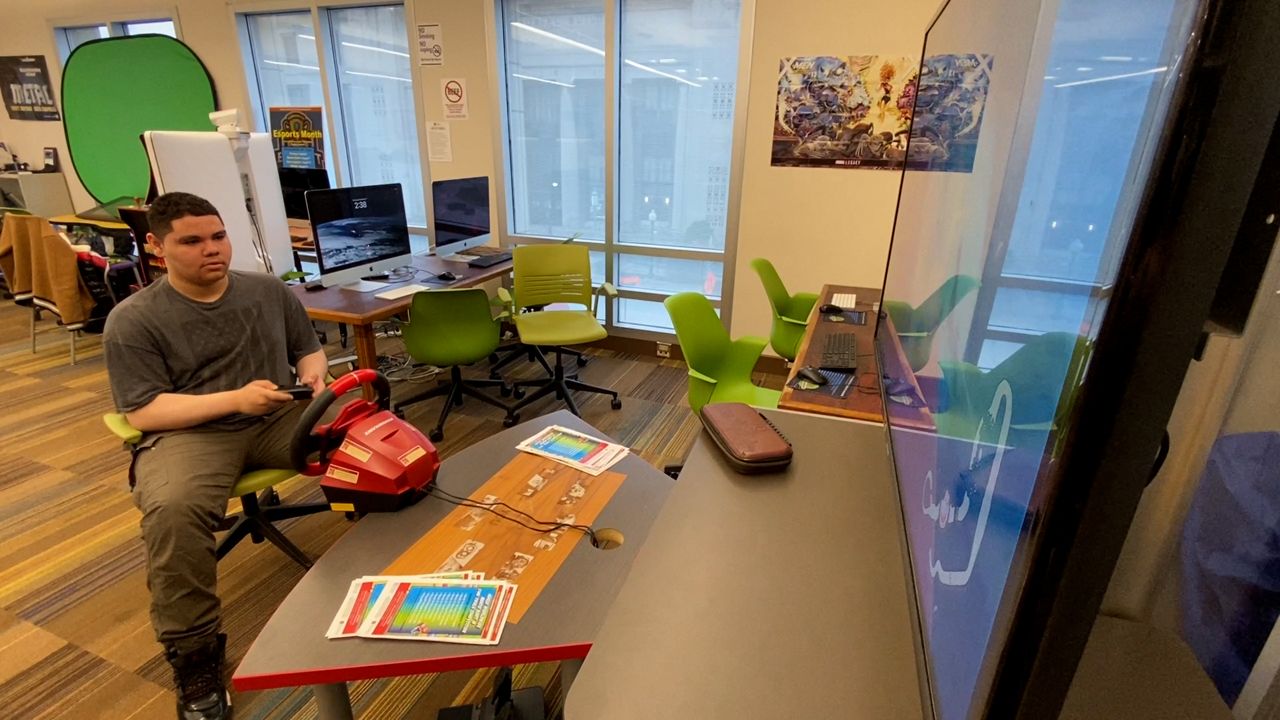ROCHESTER, N.Y. — Microplastics are small pieces of plastic ranging less than five millimeters in size that are found in our everyday environments. Research over the past few years has found microplastics everywhere from the water we drink, the ground we walk on, the air we breathe, and inevitably in our bodies. But how do they get there? And how are microplastics formed?
“We know that it’s everywhere. So finding it in a new location is not really novel. So we can begin to move to the idea of, 'OK, well, what kinds are we finding? And what’s the effect?' And it’s the same type of line of inquiry that’s happening with human health that it’s been found in blood. It’s been found in reproductive organs. It’s been found in placentas. It’s been found in breast milk. And so we’re moving now to, 'OK, it’s there. So, what’s the effect?' And there are an increasing number of studies that show that it is having a negative effect, but we have a lot more work to do to really understand that,” said Dr. Christy Tyler at the Rochester Institute of Technology.
Tyler is one of the co-directors of the Lake Ontario Center for Microplastics and Human Health in a Changing Environment, a collaboration between RIT and the University of Rochester. It was recently given a $7.3 million grant from the National Institute of Environmental Health Sciences and the National Science Foundation under the federal Oceans and Human Health Program.
The center will study the lifecycle of microplastics, their origin as plastic waste, distribution and movement in the Great Lakes freshwater ecosystem. The research starts under Tyler’s watch.
“We use these storm drain inserts that are called litter traps, which is basically a mesh basket that sits in a storm drain, and it’s about a half a foot mesh size, so anything that comes into the storm drain that’s bigger than that gets trapped,” Tyler said.
They use nine of the drains now, but there are 25,000 storm drains in the city of Rochester. In a two-week time period, Tyler and her students have been able to start their research on all of the trash collected in the drains. Tyler shows there’s everything from plastic balls, Kool-Aid pouches, hospital bands, chip wrappers, straws, cigarette butts, drug paraphernalia and toys — but the list goes on.
“Cigarette tips. We find a lot of cigarette tips; it’s one of the most common things we find. Actually, smoking debris is the top category,” she explained. “A lot of it you can identify. It’s a little bit like a treasure hunt.”
And that’s the problem.
“So if this is what’s in one drain in two weeks, you can imagine how much is is really entering through stormwater,” Tyler said.
Students are able to sort through the different types of plastics found in the designated Lake Ontario drains and organize them by category and area. However, they’re only manually able to sort through the plastics, not the microplastics.
“Plastic breaks down in the environment, and I think we hear that plastic lasts forever and it degrades really pretty slowly, but it does break down. So once it’s out in the environment, the UV radiation from the sun waves in the lake or the wind, they start to chemically and mechanically break it down,” Tyler explained. “A lot of this plastic, it may start out like this, but it’ll break down into little teeny particles. And that’s the microplastics.”
The Lake Ontario water samples are then brought in to study the environmental breakdowns of the microplastics for the project. Under a microscope, they’re able to separate some of the organic materials, like water and soil, to be able to identify what could be microplastics found in the water we use every day.
“So environmental samples that we look at ... think about being water samples, we look at soil samples, we look at mass for example, something in the environment and so we need to isolate that. And that can be a lot of work,” said chemistry professor Nathan Eddingsaas.
Nonetheless, water is just one example, as we know our waterways can evaporate into the air and soak into the ground. The cycle continues.
“First of all, we need to look at it under optical microscopy such as what we have here and look to see, but in terms of what we think are potentially plastic pieces,” Eddingsaas showed. “After we filter them out, we filter the samples out onto a gridded filter so that we can see what we’re looking for. And then we will start to, kind of from the top, and we will kind of just work out way through left to right, top to bottom, and look for what we believe are microplastics.”
Eddingsaas is one of the principal investigators at the center. He’s trained his eyes to be “quite good” at being able to identify what are likely microplastics under a microscope by observing their size, shape, color and uniqueness.
“Plastic is not cut [to] one thing. There are many types of plastics. And we need to know a.) Is it a plastic? b.) We want to know what type of plastic we have. And to do that, we use microscopy,” he explained. “When we find one, we mark down in terms of where we see it on the slide or on the filter, and then we write down in terms of what are the characteristics, we write down in terms of size, we write down in terms of morphology breakdown, in terms of color.”
This time of year, observing has become more of a skill for PIs and students alike.
“It probably is not plastic, because it isn’t quite uniform, but it’d be something that we would potentially look at later. And here we can see kind [of] a sphere, it is potentially plastic as well,” Eddingsaas demonstrated. “A lot of these pieces are more sand. You can just tell by looking a them that they’re not plastic or sand. But this white piece has a good chance of being a plastic fragment that’s going to be there. It’s kind of white, almost clear-ish, but you can see how it’s more jagged. It’s probably one.”
“Another part of this new center is trying to understand how the plastic pollution problem intersects with climate change. And in our area, climate change is bringing bigger storms, which flushes more of this kind of debris, from roadsides and parking lots and sidewalks, into storm drains and then out to the lake,” Tyler said. “With the new this new center, we’re expanding on work we’ve been doing for several years looking at microplastic in the watershed and in Lake Ontario, and trying to then collaborate with U of R health researchers to understand what’s there, what form it is, and then the potential impacts for people and human health.”
Some of these questions have started to turn into answers under the center’s other co-director’s watch. Katrina Korfmacher, a professor of environmental medicine at the University of Rochester’s Medical Center, shares the concern of not knowing the long-term effects of microplastics in our ecosystem, impacting our health.
“We know that they get into organisms. We know they get into our bodies, but how they affect the body is really unknown, and we need to put those pieces together. So, it is really scary to think about the amount of plastics that’s coming into our bodies and the fact that it’s found in all kinds of tissues,” Korfmacher explained. “What are substances in the environment? How do they get into our bodies and what do they do to us once they get there? And to really understand the problem of microplastics, we need to put those two things together.”
“My experiment is going to be trying to figure out how these microplastics enter these tadpoles, these frogs, and how they stay there and how they come out,” Rosebell Onuma, an environmental health undergraduate student, said.
“We are ingesting them all the time. So the way that biomedical research often helps answer those questions is to look at the cellular level to look at organisms like tadpoles or mice and see what they do in their bodies. Animal research has shown that there are effects of microplastics on different systems, and particularly here, looking at the effects on the development of the immune system,” Korfmacher explained.
“We’re essentially going to be making one of the tadpoles, and we’re signed up to have a treatment group where we expose them to some UV-stained microplastics, and then we’re going to have a control group that isn’t exposed to any microplastics. We’re going to leave them for an amount of time, 24 hours. Do the experiment a couple of times and see where does it end up. Does it end up in the blood? Is it specifically the red blood cells? Is it the plasma? Is it the intestine? The spleen?” Onuma explained.
Jacques Robert works in the U of R’s microbiology and immunology department, assisting in oversight of the undergraduate’s research.
“We know that they impair the immune system. So we know that already. We also know that some plastics have been going in the liver and can stay more than a week inside the liver,” Robert explained. “We are really trying to look at what type of mechanism is involved that we can maybe, you know, not just observe what’s going on, but maybe come out with something useful that we can act upon afterward.”
As a part of the upcoming generation, Onuma has a passion for this work, because she, too, fears the impacts will be too great for the future to recover from.
“We, as humans, were ingesting them, inhaling them, getting into dermal contact. You don’t want to [wait] until we figure out it’s carcinogenic and everyone is dead before we do something about it. So it’s really important that we research this now,” she said.










